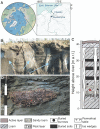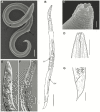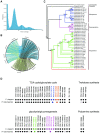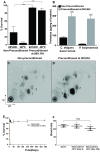A novel nematode species from the Siberian permafrost shares adaptive mechanisms for cryptobiotic survival with C. elegans dauer larva
- PMID: 37498820
- PMCID: PMC10374039
- DOI: 10.1371/journal.pgen.1010798
A novel nematode species from the Siberian permafrost shares adaptive mechanisms for cryptobiotic survival with C. elegans dauer larva
Erratum in
-
Correction: A novel nematode species from the Siberian permafrost shares adaptive mechanisms for cryptobiotic survival with C. elegans dauer larva.PLoS Genet. 2023 Sep 14;19(9):e1010943. doi: 10.1371/journal.pgen.1010943. eCollection 2023 Sep. PLoS Genet. 2023. PMID: 37708103 Free PMC article.
Abstract
Some organisms in nature have developed the ability to enter a state of suspended metabolism called cryptobiosis when environmental conditions are unfavorable. This state-transition requires execution of a combination of genetic and biochemical pathways that enable the organism to survive for prolonged periods. Recently, nematode individuals have been reanimated from Siberian permafrost after remaining in cryptobiosis. Preliminary analysis indicates that these nematodes belong to the genera Panagrolaimus and Plectus. Here, we present precise radiocarbon dating indicating that the Panagrolaimus individuals have remained in cryptobiosis since the late Pleistocene (~46,000 years). Phylogenetic inference based on our genome assembly and a detailed morphological analysis demonstrate that they belong to an undescribed species, which we named Panagrolaimus kolymaensis. Comparative genome analysis revealed that the molecular toolkit for cryptobiosis in P. kolymaensis and in C. elegans is partly orthologous. We show that biochemical mechanisms employed by these two species to survive desiccation and freezing under laboratory conditions are similar. Our experimental evidence also reveals that C. elegans dauer larvae can remain viable for longer periods in suspended animation than previously reported. Altogether, our findings demonstrate that nematodes evolved mechanisms potentially allowing them to suspend life over geological time scales.
Copyright: © 2023 Shatilovich et al. This is an open access article distributed under the terms of the Creative Commons Attribution License, which permits unrestricted use, distribution, and reproduction in any medium, provided the original author and source are credited.
Conflict of interest statement
The authors have declared that no competing interests exist.
Figures




References
Publication types
MeSH terms
LinkOut - more resources
Full Text Sources

